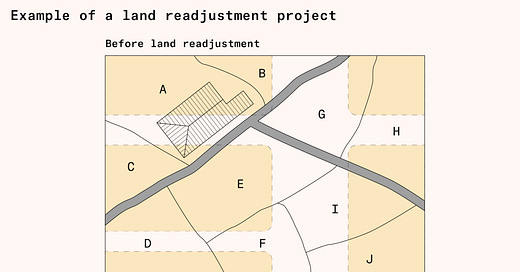Image of the day: land readjustment in Japan
How do you build roads and infrastructure when land ownership is fragmented?
How to redraw a city. Anya Martin, Works in Progress, June 2025. How do you build roads and infrastructure when land ownership is fragmented into many small lots?
In Japan, land readjustment was used successfully on a major scale after the 1923 Great Kantō Earthquake. It continues to be used today.
There are two core mechanisms inside land readjustment, both of which work by generating public legitimacy for major change. The first is sharing the proceeds of the redevelopment evenly. The second is requiring that a large majority of affected residents support the change.
An individual project begins when a promoter, usually a developer or group of landowners (or homeowners), but potentially also a city council or railway company, decides that a particular area could be used more valuably than it is now. The core idea is that some land could be more valuable if it had more or better infrastructure, whether that is sewerage and water, or, more often, a new railway station, or wider, more evenly distributed streets. In many cases this also means upzoning the land to permit denser development.
This organization or group approaches the landowners, who are often a mix of homeowners or farmers, and discusses the proposals with them. If they seem amenable, the promoter gets to work. They set up a council, which will make a new land plan for the affected area. The plan sets out the land to be used for infrastructure, the land to be sold as ‘reserve land’ to fund the project, and how the remaining land is redistributed to the owners. This last step is essential. Land readjustment aims to equalize the share of value that everyone gets, so that everyone enjoys the same percentage value uplift from the scheme. There are often parallel changes to the city plan, commonly upzoning, typically put into place on the same day as the land readjustment is passed.



